Synology DS2015xs Review: An ARM-based 10G NAS
by Ganesh T S on February 27, 2015 8:20 AM EST- Posted in
- NAS
- Storage
- Arm
- 10G Ethernet
- Synology
- Enterprise
Direct-Attached Storage Performance
The presence of 10G ports on the Synology DS2015xs presents some interesting use-cases. As an example, video production houses have a need for high-speed storage. Usually, direct-attached storage units suffice. Thunderbolt is popular for this purpose - for both single-user modes as well as part of a SAN. However, as 10G network interfaces become common and affordable, there is scope for NAS units to act as a direct-attached storage units also. In order to evaluate the DAS performance of the Synology DS2015xs, we utilized the DAS testbed augmented with an appropriate CNA (converged network adapter), as described in the previous section. To get an idea of the available performance for different workloads, we ran a couple of quick artificial benchmarks along with a subset of our DAS test suite.
CIFS
In the first case, we evaluate the performance of a CIFS share created in a RAID 5 volume. One of the aspects to note is that the direct link between the NAS and the testbed is configured with a MTU of 9000 (compared to the default of 1500 used for the NAS benchmarks).
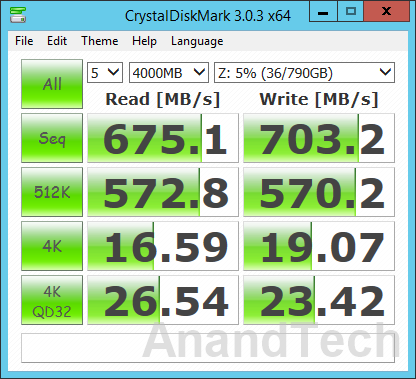
Our first artificial benchmark is CrystalDiskMark, which tackles sequential accesses as well as 512 KB and 4KB random accesses. For 4K accesses, we have a repetition of the benchmark at a queue depth of 32. As the screenshot above shows, Synology DS2015xs manages around 675 MBps reads and 703 MBps writes. The write benchmark number corresponds correctly to the claims made by Synology in their marketing material, but the 675 MBps read speeds are a far cry from the promised 1930 MBps. We moved on to ATTO, another artificial benchmark, to check if the results were any different.
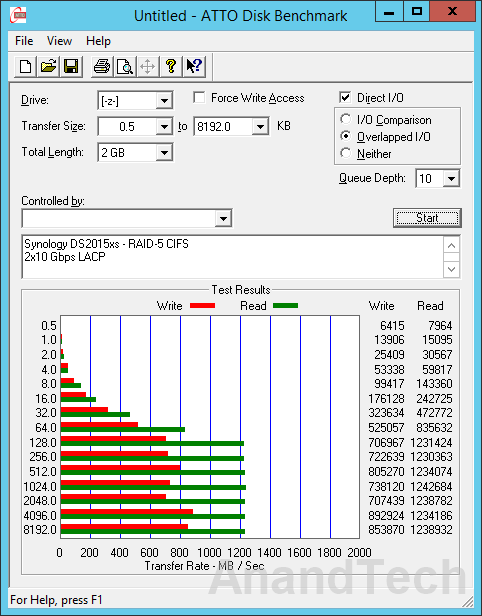
ATTO Disk Benchmark tackles sequential accesses with different block sizes. We configured a queue depth of 10 and a master file size of 4 GB for accesses with block sizes ranging from 512 bytes to 8 MB and the results are presented above. In this benchmark, we do see 1 MB block sizes giving read speeds of around 1214 MBps.
| Synology DS2015xs - 2x10 Gbps LACP - RAID-5 CIFS DAS Performance (MBps) | ||
| Read | Write | |
| Photos | 594.69 | 363.47 |
| Videos | 915.95 | 500.09 |
| Blu-ray Folder | 949.32 | 543.93 |
For real-world performance evaluation, we wrote and read back multi-gigabyte folders of photos, videos and Blu-ray files. The results are presented in the table below. These numbers show that it is possible to achieve speeds close to 1 GBps for real-life workloads. The advantage of a unit like the DS2015xs is that the 10G interfaces can be used as a DAS interface, while the other two 1G ports can connect the unit to the rest of the network for sharing the contents seamlessly with other computers.
iSCSI
We configured a block-level (Single LUN on RAID) iSCSI LUN in RAID-5 using all available disks. Network settings were retained from the previous evaluation environment. The same benchmarks were repeated in this configuration also.
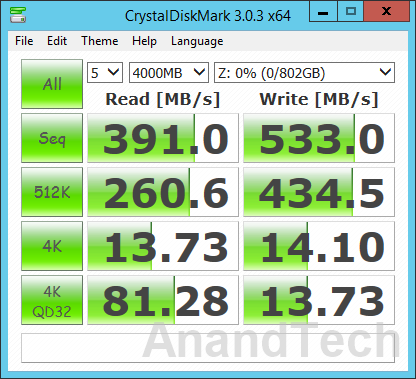
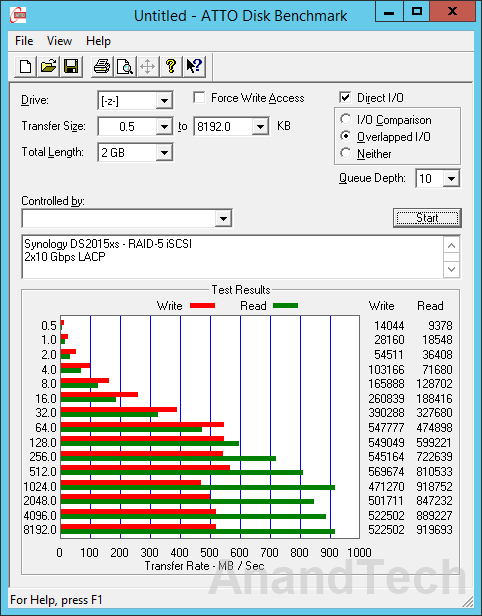
The iSCSI performance seems to be a bit off compared to what we got with CIFS. Results from the real-world performance evaluation suite are presented in the table below. These numbers track what we observed in the artificial benchmarks too.
| Synology DS2015xs - 2x10 Gbps LACP - RAID-5 iSCSI DAS Performance (MBps) | ||
| Read | Write | |
| Photos | 535.28 | 532.54 |
| Videos | 770.41 | 483.97 |
| Blu-ray Folder | 734.51 | 505.3 |
Performance Analysis
The performance numbers that we obtained with teamed ports (20 Gbps) were frankly underwhelming. The more worrisome aspect was that we couldn't replicate Synology's claims of upwards of 1900 MBps throughput for reads. In order to determine if there were any issues with our particular setup, we wanted to isolate the problem to either the disk subsystem on the NAS side or the network configuration. Unfortunately, Synology doesn't provide any tools to evaluate them separately. For optimal functioning, 10G links require careful configuration on either side.
iPerf is the tool of choice for many when it comes to ensuring that the network segment is operating optimally. Unfortunately, iPerf for DSM requires an optware package that is not yet available for the Alpine platform. On the positive side, Synology had uploaded the tool chain for Alpine on SourceForge - this helped us to cross-compile iPerf from source for the DS2015xs. Armed with iPerf on both the NAS and the testbed side, we proceeded to evaluate the links operating simultaneously without the teaming overhead.
The screenshot above shows that the two links together saturated at around 5 Gbps (out of the theoretically possible 20 Gbps), but the culprit was our cross-compiled iPerf executable (with each instance completely saturating one core - 25% of the CPU).
In the CIFS case, the smbd process is not multi-threaded, and this severely affects the utilization of the 10G links fully.
In the iSCSI case, the iscsi_trx process also seems to saturate one CPU core, leading to similar results for 10G link utilization.
On the whole, the 10G links are getting utilized, but not to the full possible extent. The utilization is definitely more than, say, four single GbE links teamed together, but the presence of two 10G links had us expecting more from the unit as a DAS.


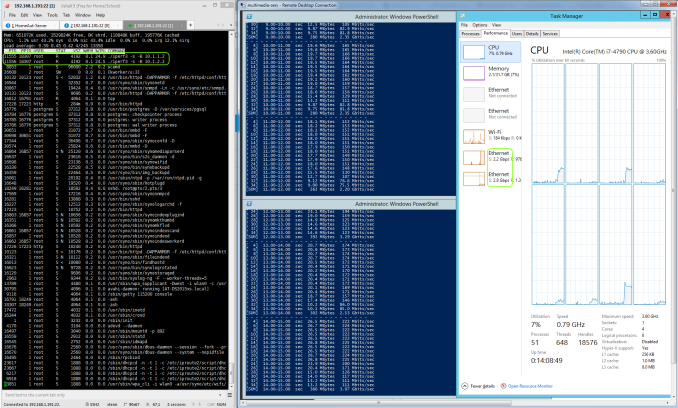
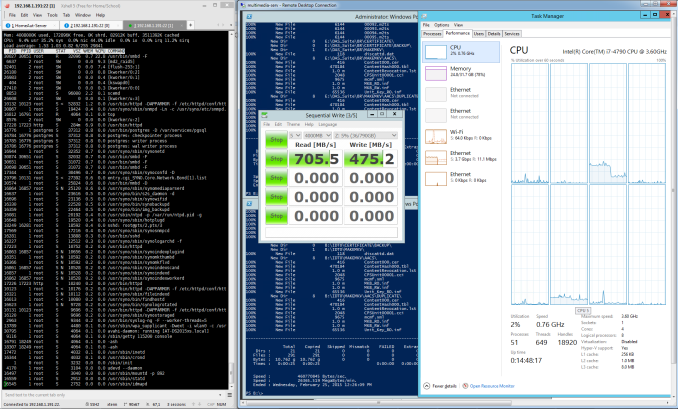
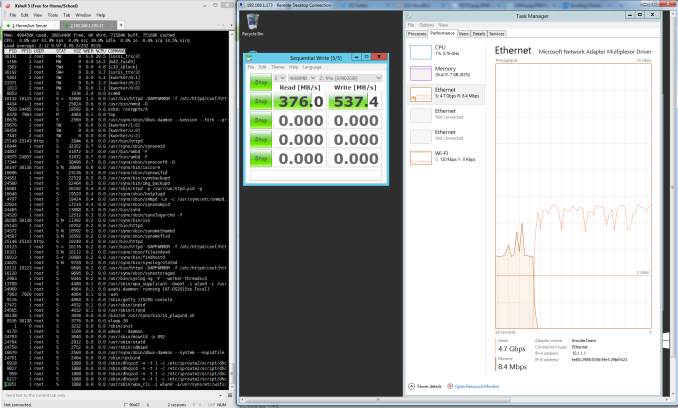








49 Comments
View All Comments
Essence_of_War - Friday, February 27, 2015 - link
Ganesh,I understand why you used 120 GB SSDs for performance to try to capture the maximum throughput of the 10GbE, but I was confused to see that you stuck with those for things like raid expansion/rebuild etc.
Was it a time constraint, or is this a change to the review platform in general? Is 8x small capacity SSDs in a RAID-5 an effective benchmark of RAID-5 rebuild times?
DanNeely - Friday, February 27, 2015 - link
When Ganesh reviewed the DS1815 using HDDs for the rebuild it took almost 200 hours to do all the rebuild tests. (Probably longer due to delays between when one finished and the next was started.) That sort of test is prohibitively time consuming.http://www.anandtech.com/show/8693/synology-ds1815...
Essence_of_War - Friday, February 27, 2015 - link
Yikes, when put that in context, that makes a lot more sense. I think we can reasonably extrapolate for larger capacities from the best-case scenario SSDs.DanNeely - Friday, February 27, 2015 - link
Repeating a request from a few months back: Can you put together something on how long/well COTS nas vendors provide software/OS updates for their products?DigitalFreak - Friday, February 27, 2015 - link
Synology is still releasing new OS updates for the 1812+ which is 3 years old.DanNeely - Saturday, February 28, 2015 - link
I poked around on their site since only 3 years surprised me; it looks like they're pushing full OS updates (at least by major version number, I can't tell about feature/app limits) as far back as the 2010 model with occasional security updates landing a few years farther back.That's long enough to make it to the upslope on the HDD failure bathtub curve, although I'd appreciate a bit longer because with consumer turnkey devices, I know a lot of the market won't be interested in a replacement before the old one dies.
M4stakilla - Friday, February 27, 2015 - link
Currently I have a desktop with an LSI MegaRAID and 8 desktop HDDs.This is nice and comfortably fast (500MB/sec+) for storing all my media.
Soon I will move from my appartement to a house and I will need to "split up" this desktop into a media center, a desktop pc and preferably some external storage system (my desktop uses quite some power being on 24/7).
I'd like this data to remain available at a similar speed.
I've been looking into a NAS, but either that is too expensive (like the above 1400$ NAS) or it is horribly slow (1gbit).
Does anyone know any alternatives that can handle at least 500MB/sec and (less important, but still...) a reasonable access time?
A small i3 / celeron desktop connected with something other than ethernet to the desktop? USB3.1 (max cable length?) Some version of eSATA? Something else? Would be nice if I could re-use my LSI megaRAID.
Anyone have ideas?
SirGCal - Friday, February 27, 2015 - link
Honestly, for playing media, you don't need speed. I have two 8 drive rigs myself, one with an LSI card and RAID 6 and one using ZFS RAIDZ2. Even hooked up to just a 1G network, it's still plenty fast to feed multiple computers live streaming BluRay content. Use 10G networks if you have the money or just chain multiple 1G's together within the system to enhance performance if you really need to. I haven't needed to yet and I host the entire house right now of multiple units. I can hit about 7 full tilt before the network would become an issue.If you're doing something else more direct that needs performance, you might consider something else then a standard network connection. But most people, using a 4-port with teaming 1G network PCIe card would be beyond overkill for the server.
M4stakilla - Sunday, March 1, 2015 - link
I do not need this speed for playing media ofcourse ;)I need it for working with my media...
And yes, I do need it for that... it is definately not a luxuary...
SirGCal - Sunday, March 1, 2015 - link
Ahh, I work my media on my regular gaming rig and then just move the files over to the server when I'm finished with them. However, without using something specific like thunderbolt, your cheapest options (though not really CHEAP) might still be using two of the 4-port teamed 1G connections. That should give you ~ 400M throughput since I get about 110M with a single 1G line. Teaming loses a tiny bit but. You'd need it at both ends. Or get a small 10G network going. I got a switch from a company sale for < $200, cards are still expensive though, realistically your most expensive option. But a single connection gets you ~ 1100M throughput.I plan on getting the new Samsung SM951. Given 2G reads, something like 1.5G writes, that might be your cheapest option. Even if you need to get a capable M.2 PCIe riser card to use it. Then you just have transfer delays to/from the server. Unless 512G isn't enough cache space for work (good lord). Again, something like that might be your cheapest option if plausible.